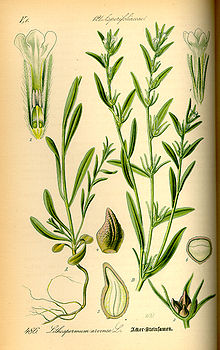Beef tongues
| Beef tongues | ||||||||||||
|---|---|---|---|---|---|---|---|---|---|---|---|---|

Thick-handled beef tongue ( Buglossoides incrassata ) |
||||||||||||
| Systematics | ||||||||||||
|
||||||||||||
| Scientific name | ||||||||||||
| Buglossoides | ||||||||||||
| Monk |
The beef tongues or stone seeds ( Buglossoides ) are a genus of plants in the family of the predatory leaf family (Boraginaceae). The 9 to 15 species are common in Eurasia .
description

Vegetative characteristics
The ox tongue species are annual or perennial herbaceous plants or subshrubs with heights of up to 0.5 meters. Stems and leaves have bristly hairs. The alternate leaves usually have no petiole , are simple and hairy on the upper side. Only the median nerve is visible on the underside. Stipules are missing.
Generative characteristics
The flowers are usually in coils . The hermaphrodite flowers are radially symmetrical and five-fold. The five sepals are fused. The overgrown crown has no folds in the throat, but only five distinct glandular or hairline ridges. The corolla lobes are significantly shorter than the corolla tube. The color of the crown is white to cream or blue to purple. There is only one circle with five stamens . Two carpels have become a top permanent ovary grown, which is divided by a false septum into four parts.
The two or four partial fruits per Klausen fruit are nut-like and each contain a seed.
Systematics
The genus Buglossoides was established in 1794 by Conrad Moench in Methodus Plantas Horti Botanici et Agri Marburgensis: a staminum situ describendi , p. 418. The botanical genus name Buglossoides is derived from the Greek words boús for beef or ox and glotta for tongue and - oides for similar.

The genus Buglossoides belongs to the tribe Lithospermeae in the subfamily Boraginoideae within the family Boraginaceae . The genus Buglossoides has sometimes been incorporated into the genus Lithospermum . In 2008 and 2014 research showed that some Buglossoides species belong to the genera Glandora D.C. Thomas & al. and Aegonychon Gray are to be provided.
The genus Buglossoides includes around 9 to 15 species, depending on the author, with only a maximum of seven species also occurring in Europe:
- Field stone seeds or field beef tongue ( Buglossoides arvensis (L.) IMJohnston )
- Buglossoides czernjajevii (Klokov) Czerep. : It occurs in Moldova and Ukraine .
- Buglossoides glandulosa (Velen.) R.Fern. : It occurs in Bulgaria and Romania.
-
Thick stalked ox tongue ( Buglossoides incrassata (Guss.) IMJohnston ): There are several subspecies:
- Buglossoides incrassata (Guss.) IMJohnston subsp. incrassata : It is common in Europe and North Africa.
- Buglossoides incrassata subsp. permixta (. Jord) L.Cecchi & Selvi (Syn .: Lithospermum permixtum Jord. , Buglossoides arvensis subsp. permixta (Jord) R.Fern.. , Buglossoides permixta (Jord) Holub. ): It was 2014 umkombiniert to this subspecies. : It occurs only in Spain and France.
- Buglossoides incrassata subsp. splitgerberi (cast.) E. Zippel & Selvi (syn .: Lithospermum splitgerberi cast. , Buglossoides arvensis subsp. splitgerberi (cast.) Giardina & Raimondo ): It occurs in Italy, Sicily, Corsica and in Germany.
- Buglossoides minima (Moris) R. Fern. : It occurs in Italy, Sicily and Sardinia.
- Buglossoides tenuiflora (L. f.) IMJohnst. : It comes from in southern Europe, western Asia and from north Africa to Afghanistan.
According to Lorenzo Cecchi et al. In 2014 a few species were spun off into the reactivated genus Aegonychon Gray :
- Aegonychon calabrum (Ten.) Holub : It occurs in Italy.
- Blue-red stone seed or blue- red beef tongue, purple-blue beef tongue, purple- blue stone seed ( Buglossoides purpurocaerulea (L.) IM Johnston → Aegonychon purpurocaeruleum (L.) Holub (syn .: Aegonychon purpurocaeruleum (L.) Holub , Lithospermum purum L. ) from southern and central Europe through Asia Minor to Iran.
According to Lorenzo Cecchi et al. In 2014 two species belong to the genus Glandora D.C. Thomas & al. :
- Buglossoides gastonii (Benth.) IMJohnst. → Glandora gastonii (Benth.) L. Cecchi & Selvi (Syn .: Lithospermum gastonii Benth. , Aegonychon gastonii (Benth.) Holub ): It occurs in Spain and France.
-
Buglossoides goulandriorum (Rech. F.) Govaerts → Glandora goulandriorum (Rech.f.) L. Cecchi & Selvi (Syn .: Lithospermum goulandriorum Rech. F. , Aegonychon goulandriorum (Rech. F.) Holub ): There are two subspecies:
- Glandora goulandriorum (Rech.f.) L.Cecchi & Selvi subsp. goulandriorum : It occurs in Greece.
- Glandora goulandriorum subsp. thessalica (Aldén) L.Cecchi & Selvi (Syn .: Aegonychon goulandriorum subsp. thessalicum (Aldén) Valdés ): It occurs in Greece.
supporting documents
- Manfred A. Fischer, Karl Oswald, Wolfgang Adler: Excursion flora for Austria, Liechtenstein and South Tyrol . 3rd, improved edition. State of Upper Austria, Biology Center of the Upper Austrian State Museums, Linz 2008, ISBN 978-3-85474-187-9 .
- HR Coleman: Buglossoides. Datasheet at FloraBase - Western Australian Flora . , accessed May 3, 2008
- Brief description in the Flora of Pakistan . (engl.)
- Buglossoides at Tropicos.org. Missouri Botanical Garden, St. Louis, accessed July 12, 2013.
- Lorenzo Cecchi, Andrea Coppi, Hartmut H. Hilger, Federico Selvi: Non-monophyly of Buglossoides (Boraginaceae: Lithospermeae): Phylogenetic and morphological evidence for the expansion of Glandora and reappraisal of Aegonychon. In: Taxon Volume 63, Issue 5, 2014, pp. 1065-1078. doi : 10.12705 / 635.4
Individual evidence
- ↑ a b c d e f g h Lorenzo Cecchi, Andrea Coppi, Hartmut H. Hilger, Federico Selvi: Non-monophyly of Buglossoides (Boraginaceae: Lithospermeae): Phylogenetic and morphological evidence for the expansion of Glandora and reappraisal of Aegonychon. In: Taxon Volume 63, Issue 5, 2014, pp. 1065-1078. doi : 10.12705 / 635.4
- ↑ a b c d e f g h i j k l m n Benito Valdés, 2011: Boraginaceae. : Datasheet Boraginaceae In: Euro + Med Plantbase - the information resource for Euro-Mediterranean plant diversity.
- ^ Buglossoides in the Germplasm Resources Information Network (GRIN), USDA , ARS , National Genetic Resources Program. National Germplasm Resources Laboratory, Beltsville, Maryland. Retrieved November 19, 2018.